Avoid the Unexpected
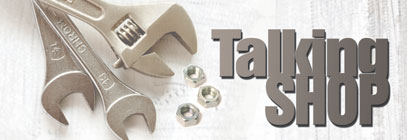
Hydraulic systems are ubiquitous in mobile and off-highway applications. When high power and precision are required for moving, positioning and braking systems on vehicles as diverse as landscaping equipment to refuse trucks and construction equipment, the hydraulic system is the ideal workhorse. Whatever the market or the application, off-highway OEMs and fleet managers demand leak-free and easy-to-maintain hydraulics with power density at a low noise level, reduced commissioning costs and precise control.
Providers of hydraulic systems and motion control equipment continue to improve power density and component reliability, while providing interfaces between hydraulic systems and higher-level control devices. This communication between hydraulically powered systems, engines and transmissions precisely manages available power to match speed and load conditions, maximizing vehicle fuel economy and minimizing emissions.
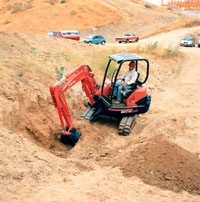
These improvements to hydraulic technology are a direct response to the requests of OEMs that design and build mobile off-highway equipment. The trend is to combine pumps, motors, reservoirs, filters and valves into one integrated package that simplifies ordering and inventory problems, reduces costs and eliminates possible leak points inherent with individually piped components. Simplifying systems and integrating components reduces both installation time and cost for the OEM, while lowering maintenance requirements for fleet managers.
Understanding and properly maintaining a vehicle’s hydraulic systems are vital to increasing production, enhancing performance and efficiency and reducing downtime. All of which contribute to a business’s healthy bottom line.
The cost of downtime in the mobile market can be merely expensive or absolutely crippling, depending upon the application. Something as simple as a hose failure can render a piece of mobile equipment inoperable. For example, in the turf industry, a downed commercial turf mower will cost a company about $110 per hour. It’s about the same for a material handling application if a telehandler or a forklift breakdown; however, it could cost as much as $1,000 per hour if a container handler shuts down. This is not good news, but not catastrophic.
The stakes get a little higher — $2,000 to $3,000 per day — if a mobile crane goes down, or $3,000 per day if a harvesting machine fails. In the refuse industry, if a truck’s front, side or rear loader shuts down, it could cost as much as $500 to $900 per hour. These are just a few examples of the cost of downtime resulting from mobile hydraulics failure.
Mobile hydraulic systems include: hydraulic fluids, reservoirs and filters; hoses, tubes and fittings; pumps and motors; actuators and cylinders; and electronic controls. All of these components need to be selected, installed and maintained properly to keep mobile equipment operating at optimum levels. But in extremely demanding off-highway mobile applications, even the best maintenance plans can be hit with unplanned downtime because of simple hose failure.
Hose Failures in Harsh Mobile Applications
Although radical improvements have been made in hose-fabrication and materials technology — including high-performance compounds as a result of advanced polymer research efforts — hoses are by no means indestructible. In general, key factors that impact hose life include size, temperature, application, operating environment, media and pressure. For example, contraction and expansion of the flexible hose structure can produce 2 percent elongation when pressurized, as well as contraction of up to 4 percent. This length differential can strain hose reinforcement wires and lead to failure.
Another major hose problem is abrasion. Manufacturers estimate that approximately 80 percent of hose failures are attributable to abrasion of some type. Motion dynamics can also spell doom for hoses out of sync with equipment movement. Harsh operating environments pose yet another considerable risk for hose performance due to the deleterious effect of extreme engineering environments.
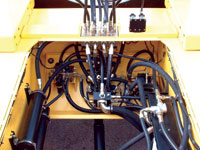
For example, leading motion and control companies, such as Parker, strive to provide safe, reliable, leak-free, factory-quality assemblies with a minimum of time and effort, supplying hose assemblies in high-volume factory production or onsite assembly for repairing mobile equipment. Typical applications include landscaping equipment, construction equipment, transportation, marine, agriculture, material handling and forestry equipment.
Pit Stop Service
Leading motion control and hydraulic equipment manufacturers have products and services to keep mobile equipment running wherever and whenever hose failures occur. For example, Parker has deployed a team of independently-owned field representatives poised to respond to customer needs as quickly as possible in the event of hose failure in the field. These technicians are available 24 hours a day, seven days week and travel onsite to replace blown hoses, provide technical assistance on hose performance parameters and update users on related practical applications.
In general, mobile applications face harsher conditions than industrial ones. Hose assemblies are often subjected to hostile operating environments and their service life is often cut short. There are many variables that come into play with hose design, making it impossible to predict the service life of any hose assembly. It all depends on how it’s used, where it’s used and how it’s maintained.
When hose assemblies do fail in the field, getting equipment up and running is critical. Mobile equipment operators sometimes accidentally slash or otherwise damage hoses and connectors. When that happens, onsite hose maintenance can provide both product and service to reduce a customer’s downtime by being timely in making repairs and getting the process back on track as quickly as possible.
Time can be a particularly critical factor in some construction projects. Consider construction and earth-moving equipment used by municipalities. When road construction equipment is down due to hose failure, workers are idled. But even more important, municipalities can impose stiff fines on contractors when highway construction projects are delayed or late.
To help reduce untimely failures, hose technicians make regular customer calls to provide preventive maintenance services, replace worn hoses and restock supplies. These employees can also help educate customers about factors that affect hose wear, providing tips on how to select the right hose and fittings for the application, as well as providing guidelines on proper installation techniques.
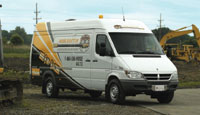
Dennis Warburton is a hydraulic and pneumatic business manager for Mega Fluidline Products Inc., a Parker distributor that owns and operates four Parker Stores in Northeast Ohio.
Identifying Hose FailuresSolutions to Six Common Hose Failure Scenarios
Solution: Check to see if the hose can be re-routed. Use clamps to hold the hose or provide a hose guard on the replacement hose as additional protection. 2. Excessive Heat: The hose cover and/or the inner tube are brittle to the touch and have a cracked appearance. The hose is not flexible at room temperature. Solution: Using the STAMPED method, choose a hose that has the correct temperature rating for the application and provides additional protection with heat shields or fire jackets. The STAMPED method ensures the correct hose style is used for a replacement, representing the hose Size, Temperature, Application, Medium, Pressure, Ends and Delivery. 3. Excessive Pressure: The hose has burst cleanly with no random wire breakage or cover abrasion. Solution: Using the STAMPED method, verify the system operating pressure and correct setting. Choose a hose that meets or exceeds the pressure rating for the application.
Solution: Ensure the correct assembly procedures have been followed. Refer to your product’s catalogs for guidelines or hose stockist. Ensure that only the correctly matched parts have been used with a particular fitting and with a particular hose and never mix components from different manufacturers. 5. End Fitting Broken Off: The fitting has broken off, leaving some or all of the fitting tail inside the inner tube with the ferrule still attached. Solution: The fitting has broken off due to outside influence. Try to identify the source of this outside damage and eliminate it by re-routing the hose or correctly routing the hose in the case of a previous repair. Always re-use any brackets that are provided by the manufacturer. 6. Incompatible Fluid: The inner tube is deteriorated, swollen and the outer cover may be peeling off. Solution: Use the STAMPED process to establish the correct hose for this application referring to the chemical compatibility chart for guidance. |

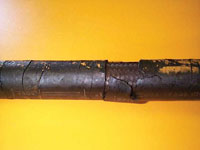 1. Abrasion: The hose has failed with clear signs of rubbing on the outer cover.
1. Abrasion: The hose has failed with clear signs of rubbing on the outer cover.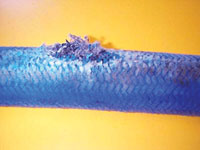 4. End Fitting Blown Off: The end fitting has blown off the hose either with or without the ferrule, which is the collar that is crimped to the hose and prevents the fitting from coming out of the hose assembly, with no other external damage evident.
4. End Fitting Blown Off: The end fitting has blown off the hose either with or without the ferrule, which is the collar that is crimped to the hose and prevents the fitting from coming out of the hose assembly, with no other external damage evident.
Comments are closed here.